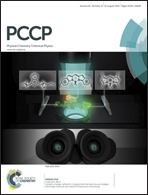Location change method for imaging chemical reactivity and catalysis with single-molecule and -particle fluorescence microscopy
Abstract
In the last eight years, it has become possible to image chemical reactivity at the single-molecule and -particle level with fluorescence microscopy. This Perspective describes one of the imaging techniques that enabled this state-of-the-art application: imaging by the location change of molecules and particles. In this method, the microscope and experiment are configured to produce a signal when an individual molecule or particle changes location or changes mobility concurrently with a chemical change. This imaging technique has enabled observation of single chemical reactions and unraveled mechanisms of complex chemical and physical processes in transition metal and polymerization systems. This Perspective has three major goals: (1) to unify studies of different chemical processes or of different chemical questions, which, in spite of these differences, employ a similar microscopy detection method, (2) to explain the technique to nonexperts and those who might be interested in joining this nascent field, and (3) to highlight unique information available through this cross-disciplinary technique and the value this information has for chemical reaction development generally and catalysis specifically. To this end, application of the location change method to the investigation of polymerization reactions with radical initiators and separately with metal catalysts, and to ligand exchange reactions at platinum complexes are described.


 Please wait while we load your content...
Please wait while we load your content...